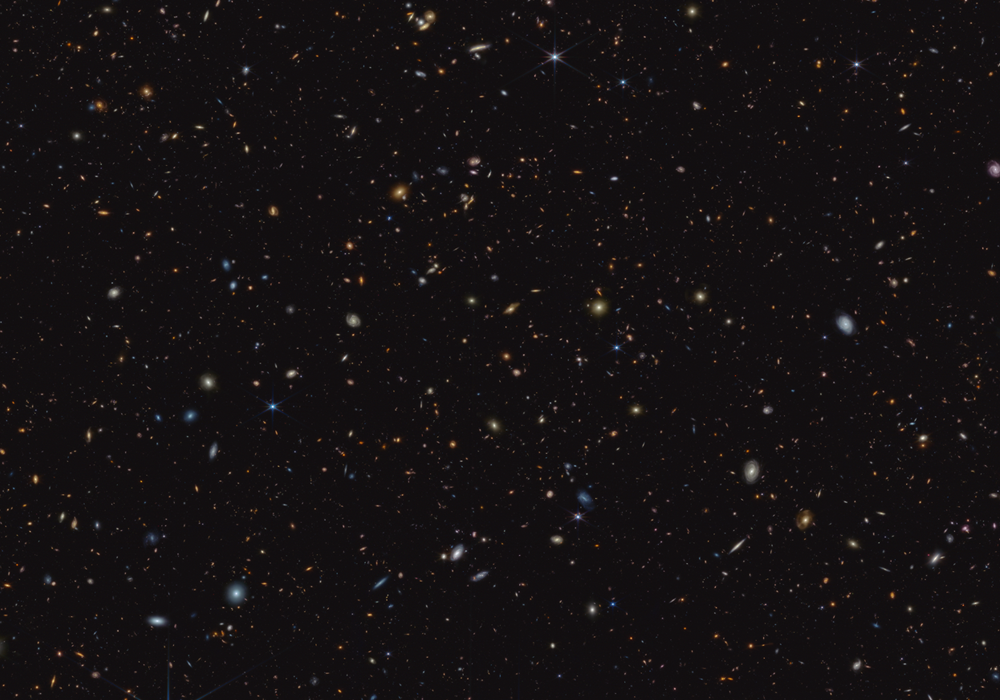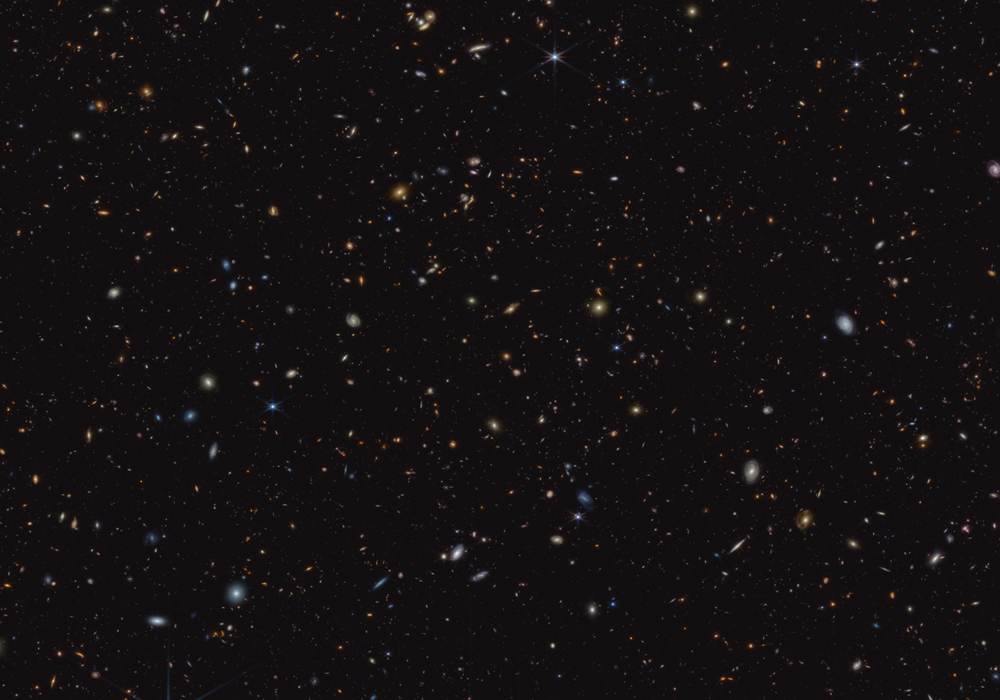Dark Star Hypothesis Sees the Light of Day
The first stars were likely very different from the stars that light up our nights. The common hypothesis is that the first generation of stars were big—as much as a hundred times more massive than our Sun—and that they shone hot and bright from nuclear reactions in their cores. Another possibility is that these stars were powered by dark matter. Recent results from the JWST space observatory have identified three early-Universe objects that could potentially be supermassive dark stars weighing a million times the mass of our Sun [1]. Experts say more evidence is needed to confirm the sightings.
The ingredients for star formation have dramatically evolved over the Universe’s history. The first stars formed about 200 million years after the big bang out of gas clouds made almost entirely from hydrogen and helium—heavier elements only came later after several cycles of star formation. The lack of heavy elements impacted the way these clouds cooled and collapsed under gravity. Models suggest that the gas in the clouds eventually became dense enough and hot enough to ignite nuclear fusion, just as in current stars. However, astrophysicists predict that these first stars—called Population III stars—were extremely massive and short lived.
Astronomers have yet to directly observe Population III stars, so it remains an open problem whether the first stars really formed in this way. In 2008, Katherine Freese, who is now at the University of Texas at Austin, and her colleagues entertained another possibility: that the first stars were fueled by dark matter [2]. Initially, the researchers were unsure if these objects would emit enough light to be visible, so they called them dark stars. Later, they calculated that a single dark star could be as bright as a galaxy. “The name dark star turned out to be a misnomer,” Freese says. “But we liked it because it’s also the title of songs by the Grateful Dead and Crosby, Stills, and Nash.”
The model by Freese and her colleagues assumes that dark stars form in clouds made mostly of hydrogen, with dark matter contributing just 0.1% of the mass. When two of these dark matter particles collide, they can annihilate each other, releasing photons, electrons, and other particles. Most of these by-products stay in the cloud, depositing heat into its gas, and causing it to glow—just like a normal star. “These dark stars are really atomic stars with the ‘power of darkness,’” Freese says.
“Dark stars are a theoretically intriguing idea,” says Julian Muñoz, a cosmologist at the University of Texas at Austin who was not involved in the current work. “Self-annihilations are a fairly generic signature of many dark matter models,” he says. And they are a central feature in one popular model, in which dark matter is made up of weakly interacting massive particles, or WIMPs.
WIMPs self-annihilate at a rate that is proportional to their density. According to the model of Freese and her colleagues, WIMP self-annihilation would have been a significant source of energy in early-Universe gas clouds with masses roughly equivalent to our Sun. The resulting dark stars would have had surface temperatures of around 10,000 K, enough to make them glow brightly but not enough to prevent additional matter from accreting onto them. In their models, the researchers found that dark stars can grow to have the mass of a million Suns and can emit the light of a billion Suns. These supermassive dark stars are what Freese and her team now claim to have found in JWST data.
The powerful lens of JWST has so far revealed over 700 objects that appear to date from the earliest epoch of star formation. This number is uncomfortably large, Freese says, as standard cosmological models don’t predict such a bright early Universe. As of now, it’s unclear what these objects are, as the data are not precise enough to make any identifications. However, the JWST team has performed follow-up spectroscopic measurements on a small sampling of these objects [3]. Data from five objects in this sample have been released to the public and, based on the analysis by Freese and her colleagues, three of those five could be dark stars.
“This is a really exciting development,” says particle physicist Pearl Sandick from the University of Utah. “Many of us have been eagerly awaiting this type of analysis, which could only be done once adequate spectral information from JWST was available.” For an object to be a dark star it should have a thermal (blackbody) spectrum, which all three dark star candidates appear to have. But the spectra are also consistent with those of galaxies filled with normal stars. “These objects can be explained using standard galaxy models,” says astronomer Marcia Rieke from the University of Arizona, who was part of the team that collected the spectral data. She admits, however, that the quality of the spectra is not yet good enough to rule out dark stars and other exotic explanations.
One way to unambiguously identify these objects would be to take more data and to look for spectral features. If the objects are dark stars, their spectra should have a helium absorption line at 164 nm. Find that line and we will have “the smoking gun” of a dark star, Freese says. It might be impractical to search for this spectral feature in the current crop of objects, but JWST will see more candidates in the future. It is almost guaranteed that one of them will be magnified by gravitational lensing, Freese says. “Once you’ve magnified one of those guys, you’re going to get better information…that’s what it’ll take to confirm dark star existence.”
That evidence will likely be needed for dark stars to catch on with astronomers such as Rebecca Bowler from the University of Manchester, UK. “I would say that the majority of astronomers would back the standard picture that the first stars were Population III stars,” she says. Bowler says that recent JWST observations have provided some exciting hints of Population III stars, which she thinks makes them the more viable candidate for the first stars. “I would caution that we don’t know what dark matter is,” she adds. “And hence these models are already by their nature highly uncertain.”
Freese agrees that Population III stars are a better bet, but she thinks that the two models are not mutually exclusive. “If dark matter is a WIMP, you’re going to get dark stars first—like it or not,” she says. “Then sure, down the road, you’re going to get the regular Population III stars.”
–Michael Schirber
Michael Schirber is a Corresponding Editor for Physics Magazine based in Lyon, France.
References
- C. Ilie et al., “Supermassive Dark Star candidates seen by JWST,” Proc. Natl. Acad. Sci. U.S.A. 120 (2023).
- D. Spolyar et al., “Dark matter and the first stars: A new phase of stellar evolution,” Phys. Rev. Lett. 100, 051101 (2008).
- B. E. Robertson et al., “Identification and properties of intense star-forming galaxies at redshifts z > 10,” Nat. Astron. 7, 611 (2023).





